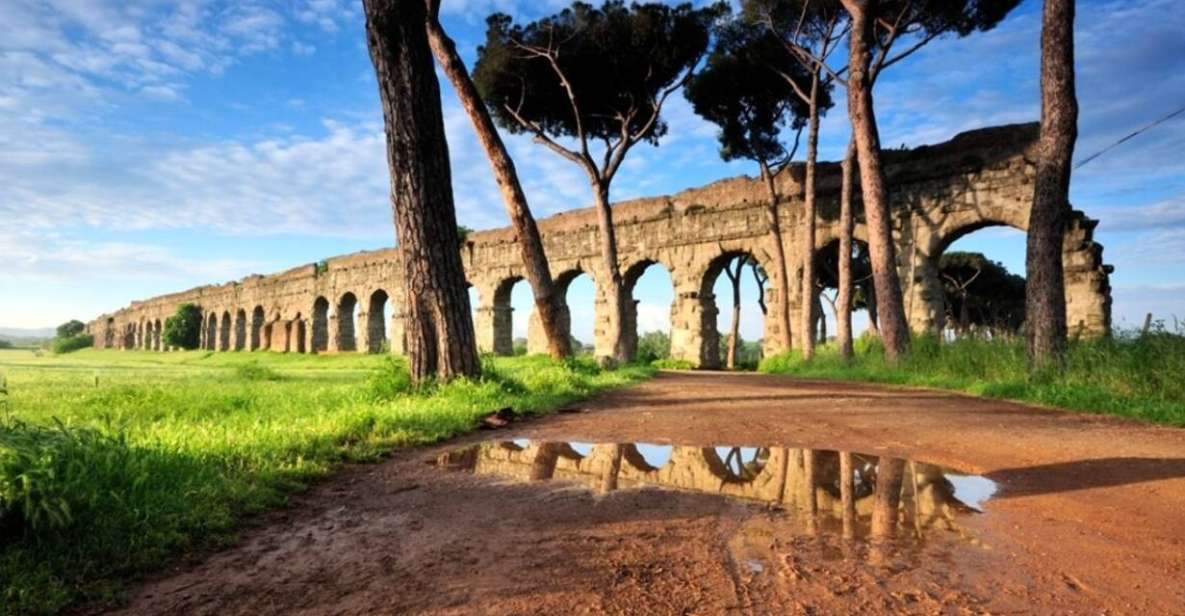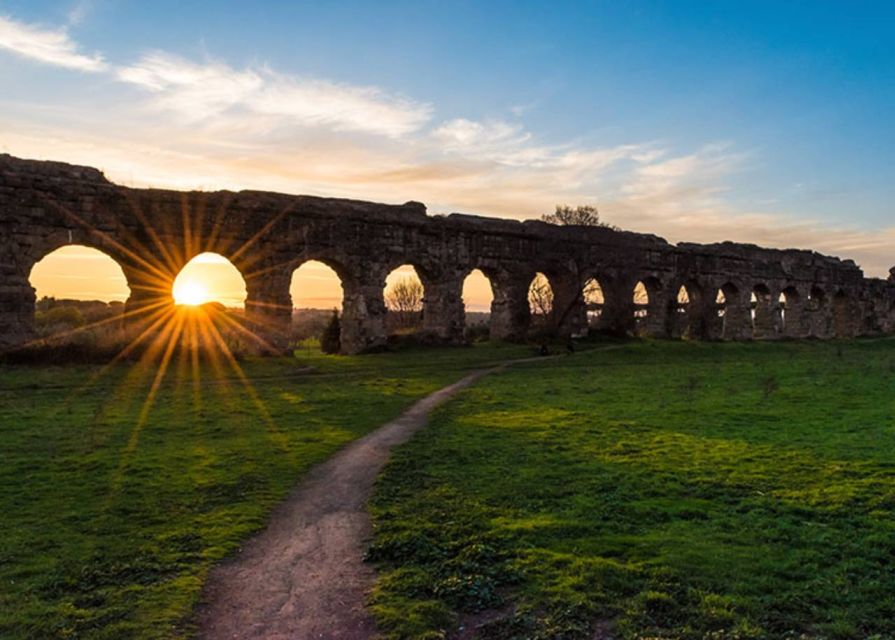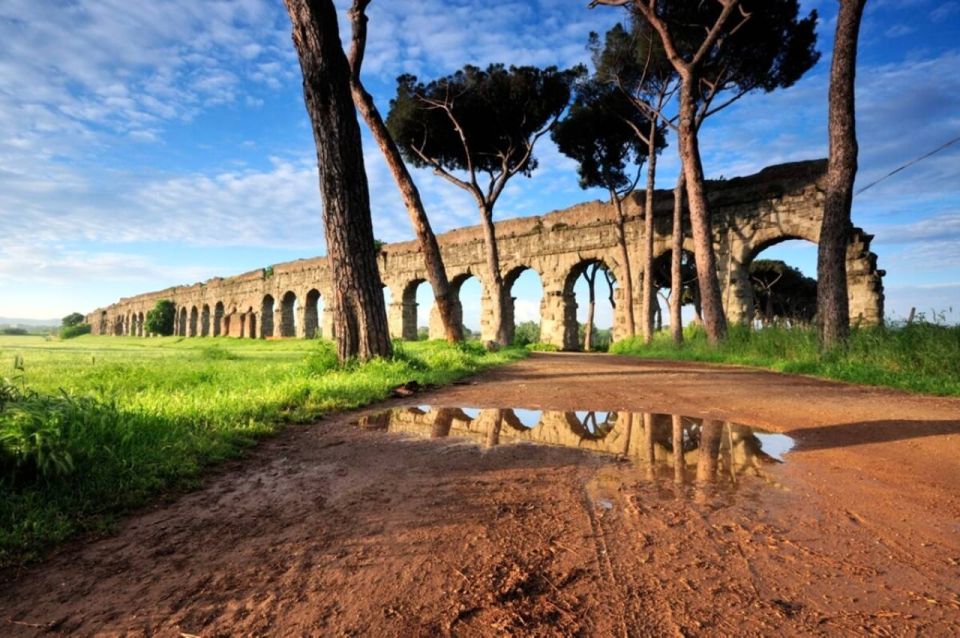Imposing and enduring, the Ancient Aqueducts of Rome stand as silent witnesses to an era of unparalleled engineering and innovation. These monumental structures, crafted with meticulous precision, not only reflect the architectural prowess of the Roman Empire but also hold within them the secrets of a civilization that harnessed the power of water for its survival and prosperity.
As we trace the paths of these ancient conduits, we uncover a narrative that transcends time, offering a glimpse into the past that continues to shape our present understanding of history and heritage.
Just The Basics

- Aqueducts in Rome supplied clean water for public use, showcasing advanced engineering.
- Roman aqueducts improved public health, sanitation, and quality of life significantly.
- Parco Degli Acquedotti offers a unique exploration of ancient Roman aqueducts.
- Aqueduct tours provide an intimate experience in understanding Rome’s water distribution system.
It’s also worth checking out some other tours and experiences nearby.
Historical Significance of Aqueducts

The aqueducts of ancient Rome, a marvel of engineering and ingenuity, played a crucial role in supplying the city with the precious resource of water, shaping the development and sustainability of the Roman Empire.
These engineering marvels enabled the efficient distribution of water across vast distances, allowing for the growth and expansion of the city. The aqueducts not only provided water for daily needs but also supported public baths, fountains, and even private homes, showcasing their significance in improving the quality of life for Roman citizens.
Through a sophisticated network of channels and arches, water was transported from distant sources to urban centers, highlighting the advanced technological achievements of the Romans in ensuring water supply and sanitation for their growing population.
Construction Techniques and Engineering Feats

Utilizing innovative methods and intricate designs, the construction of ancient Roman aqueducts exemplified unparalleled engineering prowess and sophistication. Aqueduct design in Rome was a testament to the ingenuity of Roman engineers, who employed various techniques to transport water over long distances with precision. The aqueducts featured a combination of underground tunnels, elevated arches, and gravity-fed channels to ensure a steady flow of water to the city. These structures not only facilitated water transportation but also showcased the Romans’ mastery of hydraulic engineering. The table below provides a glimpse into the remarkable construction techniques and engineering feats employed in the creation of these ancient aqueducts.
| Construction Techniques | Engineering Feats | Innovation in Design |
|---|---|---|
| Elevated arches | Gravity-fed channels | Underground tunnels |
| Strategic slope gradients | Precision in water flow | Structural stability |
Role of Aqueducts in Ancient Rome

Engineers in ancient Rome ingeniously harnessed aqueducts to supply the bustling city with a reliable source of water, underscoring the critical role these monumental structures played in sustaining daily life and urban development.
Aqueducts were crucial in providing clean water for public baths, fountains, and private homes, significantly improving public health and sanitation in the city. The preservation of aqueducts was meticulously maintained to ensure a steady flow of water, with constant repairs and upkeep efforts.
These systems not only met the basic needs of the population but also facilitated the growth and expansion of Rome, enabling the city to flourish as a center of civilization. The aqueducts stood as a testament to Roman engineering prowess and their commitment to enhancing the quality of life through efficient water supply systems.
Exploration of Parco Degli Acquedotti
Amidst the tranquil expanse of Parco Degli Acquedotti lies a captivating journey through the ancient engineering marvels that once supplied water to the heart of Rome. Visitors have the opportunity to explore the rich history of Rome by exploring the aqueducts that stand as a testament to the ingenuity of Roman engineering.
Aqueduct photography enthusiasts will find ample opportunities to capture the grandeur of these structures, with their impressive arches and historical significance. For those seeking a more adventurous experience, aqueduct hiking provides a unique way to take in the ancient landscape and appreciate the monumental effort that went into constructing these vital waterways.
Parco Degli Acquedotti offers a serene setting away from the bustling tourist hubs, allowing participants to touch history and witness the legacy of Roman civilization firsthand.
Practical Tips for Aqueduct Tours
When preparing for aqueduct tours at Parco Degli Acquedotti, it is essential to consider practical tips to enhance your experience and make the most of your exploration.
For accessibility tips, note that the activity is wheelchair accessible, but some areas may have uneven terrain.
Considering group dynamics, the tours are limited to small groups of 10 participants to ensure an intimate experience.
To learn about the local culture, consider trying out some authentic Roman cuisine at nearby eateries after the tour.
Remember to wear comfortable shoes and weather-appropriate clothing. Bringing a refillable water bottle and sunscreen is advisable.
Here’s a few more nearby tours and experiences we think you’ll like.
Frequently Asked Questions
Are There Any Specific Restrictions on Photography During the Tour of Parco Degli Acquedotti?
Photography guidelines and etiquette are important during the tour to respect the cultural significance and preservation efforts of Parco degli Acquedotti. Participants should adhere to any restrictions set by the tour guide for the group’s benefit.
How Far in Advance Should Participants Arrive at the Starting Location for the Aqueduct Tour?
Participants should aim to arrive at the starting location for the aqueduct tour at least 15-20 minutes before the scheduled departure time. Transportation options vary, so plan accordingly. Gain insights into the historical background and aqueduct construction during this informative experience.
Is There a Recommended Dress Code for Walking Along the Aqueducts in the Park?
For walking along the aqueducts in the park, it is recommended to wear comfortable and sturdy footwear, such as closed-toe sneakers or hiking shoes. Consider weather conditions; bring a light jacket for cooler days.
Are There Restroom Facilities Available Along the Route of the Aqueduct Tour?
Restroom access is available along the route of the aqueduct tour, ensuring convenience for participants during the 2-hour duration. Facilities are strategically located to accommodate the needs of visitors throughout the guided exploration.
Is There Any Recommended Preparation or Reading Material to Enhance the Understanding of the Aqueducts Before the Tour?
For a comprehensive understanding of the aqueducts before the tour, recommended preparation materials could include historical books on Roman engineering, articles on ancient water systems, or documentaries showcasing the significance of aqueducts in ancient civilizations.
Not for you? Here’s more of our most recent tour reviews happening neaby
- Rome Borghese Gallery Skip-the-Line Small Group Tour
- Rome: Vatican Museums & Sistine Chapel Masterpieces Tour
- Vatican: St. Peter’s Basilica, Papal Tombs & Dome VIP Tour
- Rome By Night: Small Group E-Bike Tour
- Rome: 2-Hour Private Walking Tour From Piazza Navona
- Rome: Street Food Tour in the Heart of Rome
- The BEST Rome Tours and Things to Do
- Fettuccine, Ravioli and Tiramisu Making in Piazza Cavour
- Rome: Catacombs of Rome and Main Basilicas Half-Day Tour
- Rome: History of Christianity Tour With Vatican & Catacombs
- Day Trip Rome: Bracciano, Anguillara & Trevignano Romano
- Day Trip Rome by Car : Tivoli Unesco Villa D’este & Hadrian
- Rome: Pasta and Tiramisù Cooking Class With Wine
- Rome: Private E-Bike Tour With Local Food
- Rom: Historical Highlights Walking Tour in German Language
Final Words
To sum it up, the Ancient Aqueducts of Rome offer a fascinating glimpse into the engineering prowess and historical importance of the Roman Empire. Through guided tours at Parco degli Acquedotti, visitors can appreciate the intricate construction and vital role of these structures in supplying water to the city.
This immersive experience provides a unique opportunity to walk among the ancient arches and explore Rome’s architectural legacy, making it a must-visit for history enthusiasts and curious travelers alike.

Leave a Reply